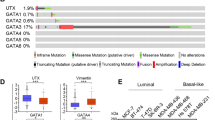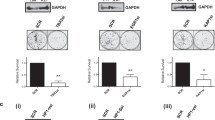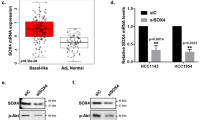Abstract
The transcription factor GATA3 is a key regulator of mammary gland development and a definitive marker of luminal breast cancer. However, the molecular mechanisms underlying the role of GATA3 in breast carcinogenesis is still not fully understood. We report here that GATA3 promotes cell proliferation and tumorigenesis by facilitating the G1/S transition through its transcription regulation of the CCND1 gene in breast cancer cells. We found that GATA3 is physically associated with poly-ADP ribose polymerase-1 (PARP1), an enzyme modifying nuclear proteins by poly(ADP-ribosyl)ation. We showed that PARP1 acts as a transcription coactivator for GATA3 in breast cancer cells and demonstrated that GATA3 cooperates with PARP1 in transactivation of the CCND1 gene. We demonstrated that PARP1 competes with linker histone H1 to maintain a transcriptional competent chromatin environment for CCND1 gene. Our results unveiled a molecular basis for the coordinated regulation between GATA3 and PARP1 in transcription activation, providing a mechanism for GATA3 in breast carcinogenesis.
This is a preview of subscription content, access via your institution
Access options
Subscribe to this journal
Receive 50 print issues and online access
$259.00 per year
only $5.18 per issue
Buy this article
- Purchase on Springer Link
- Instant access to full article PDF
Prices may be subject to local taxes which are calculated during checkout







Similar content being viewed by others
References
Patient RK, McGhee JD . The GATA family (vertebrates and invertebrates). Curr Opin Genet Dev 2002; 12: 416–422.
Hoene V, Fischer M, Ivanova A, Wallach T, Berthold F, Dame C . GATA factors in human neuroblastoma: distinctive expression patterns in clinical subtypes. Br J Cancer 2009; 101: 1481–1489.
Tsarovina K, Pattyn A, Stubbusch J, Muller F, van der Wees J, Schneider C et al. Essential role of GATA transcription factors in sympathetic neuron development. Development 2004; 131: 4775–4786.
Imagawa S, Yamamoto M, Miura Y . Negative regulation of the erythropoietin gene expression by the GATA transcription factors. Blood 1997; 89: 1430–1439.
Zhang C, Ye X, Zhang H, Ding M, Deng H . GATA factors induce mouse embryonic stem cell differentiation toward extraembryonic endoderm. Stem Cells Dev 2007; 16: 605–613.
Zheng W, Flavell RA . The transcription factor GATA-3 is necessary and sufficient for Th2 cytokine gene expression in CD4 T cells. Cell 1997; 89: 587–596.
Taghon T, Yui MA, Rothenberg EV . Mast cell lineage diversion of T lineage precursors by the essential T cell transcription factor GATA-3. Nat Immunol 2007; 8: 845–855.
Ho IC, Tai TS, Pai SY . GATA3 and the T-cell lineage: essential functions before and after T-helper-2-cell differentiation. Nat Rev Immunol 2009; 9: 125–135.
Ting CN, Olson MC, Barton KP, Leiden JM . Transcription factor GATA-3 is required for development of the T-cell lineage. Nature 1996; 384: 474–478.
Kouros-Mehr H, Slorach EM, Sternlicht MD, Werb Z . GATA-3 maintains the differentiation of the luminal cell fate in the mammary gland. Cell 2006; 127: 1041–1055.
Kouros-Mehr H, Kim JW, Bechis SK, Werb Z . GATA-3 and the regulation of the mammary luminal cell fate. Curr Opin Cell Biol 2008; 20: 164–170.
Asselin-Labat ML, Sutherland KD, Barker H, Thomas R, Shackleton M, Forrest NC et al. Gata-3 is an essential regulator of mammary-gland morphogenesis and luminal-cell differentiation. Nat Cell Biol 2007; 9: 201–209.
Zheng R, Blobel GA . GATA transcription factors and cancer. Genes Cancer 2010; 1: 1178–1188.
Mehra R, Varambally S, Ding L, Shen R, Sabel MS, Ghosh D, et al. Identification of GATA3 as a breast cancer prognostic marker by global gene expression meta-analysis. Cancer Res 2005; 65: 11259–11264.
Ciocca V, Daskalakis C, Ciocca RM, Ruiz-Orrico A, Palazzo JP . The significance of GATA3 expression in breast cancer: a 10-year follow-up study. Human Pathol 2009; 40: 489–495.
Yoon NK, Maresh EL, Shen D, Elshimali Y, Apple S, Horvath S, et al. Higher levels of GATA3 predict better survival in women with breast cancer. Human Pathol 2010; 41: 1794–1801.
Hoch RV, Thompson DA, Baker RJ, Weigel RJ . GATA-3 is expressed in association with estrogen receptor in breast cancer. Int J Cancer 1999; 84: 122–128.
Parikh P, Palazzo JP, Rose LJ, Daskalakis C, Weigel RJ . GATA-3 expression as a predictor of hormone response in breast cancer. J Am Collf Surg 2005; 200: 705–710.
Wilson BJ, Giguere V . Meta-analysis of human cancer microarrays reveals GATA3 is integral to the estrogen receptor alpha pathway. Mol Cancer 2008; 7: 49.
Kouros-Mehr H, Bechis SK, Slorach EM, Littlepage LE, Egeblad M, Ewald AJ et al. GATA-3 links tumor differentiation and dissemination in a luminal breast cancer model. Cancer Cell 2008; 13: 141–152.
Yan W, Cao QJ, Arenas RB, Bentley B, Shao R . GATA3 inhibits breast cancer metastasis through the reversal of epithelial-mesenchymal transition. J Biol Chem 2010; 285: 14042–14051.
Tkocz D, Crawford NT, Buckley NE, Berry FB, Kennedy RD, Gorski JJ et al. BRCA1 and GATA3 corepress FOXC1 to inhibit the pathogenesis of basal-like breast cancers. Oncogene 2011; 31 (32): 3667–3678.
Eeckhoute J, Keeton EK, Lupien M, Krum SA, Carroll JS, Brown M . Positive cross-regulatory loop ties GATA-3 to estrogen receptor alpha expression in breast cancer. Cancer Res 2007; 67: 6477–6483.
Rosenfeld MG, Lunyak VV, Glass CK . Sensors and signals: a coactivator/corepressor/epigenetic code for integrating signal-dependent programs of transcriptional response. Genes Dev 2006; 20: 1405–1428.
Xu L, Glass CK, Rosenfeld MG . Coactivator and corepressor complexes in nuclear receptor function. Curr Opin Genet Dev 1999; 9: 140–147.
Kurokawa R, Rosenfeld MG, Glass CK . Transcriptional regulation through noncoding RNAs and epigenetic modifications. RNA Biol 2009; 6: 233–236.
Wolffe AP, Guschin D . Review: chromatin structural features and targets that regulate transcription. J Struct Biol 2000; 129: 102–122.
Hwang SS, Lee S, Lee W, Lee GR . GATA-binding protein-3 regulates T helper type 2 cytokine and ifng loci through interaction with metastasis-associated protein 2. Immunology 2010; 131: 50–58.
Blokzijl A, ten Dijke P, Ibanez CF . Physical and functional interaction between GATA-3 and Smad3 allows TGF-beta regulation of GATA target genes. Curr Biol 2002; 12: 35–45.
Wei G, Abraham BJ, Yagi R, Jothi R, Cui K, Sharma S et al. Genome-wide analyses of transcription factor GATA3-mediated gene regulation in distinct T cell types. Immunity 2011; 35: 299–311.
Kim MY, Mauro S, Gevry N, Lis JT, Kraus WL . NAD+-dependent modulation of chromatin structure and transcription by nucleosome binding properties of PARP-1. Cell 2004; 119: 803–814.
Mao Z, Hine C, Tian X, Van Meter M, Au M, Vaidya A et al. SIRT6 promotes DNA repair under stress by activating PARP1. Science 2011; 332: 1443–1446.
Bouchard VJ, Rouleau M, Poirier GG . PARP-1, a determinant of cell survival in response to DNA damage. Exp Hematol 2003; 31: 446–454.
Huber A, Bai P, de Murcia JM, de Murcia G . PARP-1, PARP-2 and ATM in the DNA damage response: functional synergy in mouse development. DNA Repair 2004; 3: 1103–1108.
Krishnakumar R, Kraus WL . The PARP side of the nucleus: molecular actions, physiological outcomes, and clinical targets. Mol Cell 2010; 39: 8–24.
Krishnakumar R, Kraus WL . PARP-1 regulates chromatin structure and transcription through a KDM5B-dependent pathway. Mol Cell 2010; 39: 736–749.
Lonn P, van der Heide LP, Dahl M, Hellman U, Heldin CH, Moustakas A . PARP-1 attenuates Smad-mediated transcription. Mol Cell 2010; 40: 521–532.
Kraus WL . Transcriptional control by PARP-1: chromatin modulation, enhancer-binding, coregulation, and insulation. Curr Opin Cell Biol 2008; 20: 294–302.
Arnold A, Papanikolaou A . Cyclin D1 in breast cancer pathogenesis. J Clin Oncol 2005; 23: 4215–4224.
Bartkova J, Lukas J, Muller H, Lutzhoft D, Strauss M, Bartek J . Cyclin D1 protein expression and function in human breast cancer. International journal of cancer. J Int Cancer 1994; 57: 353–361.
Gillett C, Fantl V, Smith R, Fisher C, Bartek J, Dickson C et al. Amplification and overexpression of cyclin D1 in breast cancer detected by immunohistochemical staining. Cancer Res 1994; 54: 1812–1817.
Fantl V, Smith R, Brookes S, Dickson C, Peters G . Chromosome 11q13 abnormalities in human breast cancer. Cancer Surveys 1993; 18: 77–94.
Cipak L, Jantova S . PARP-1 inhibitors: a novel genetically specific agents for cancer therapy. Neoplasma 2010; 57: 401–405.
Tulin A . Re-evaluating PARP1 inhibitor in cancer. Nat Biotechnol 2011; 29: 1078–1079.
Ossovskaya V, Koo IC, Kaldjian EP, Alvares C, Sherman BM . Upregulation of poly (ADP-ribose) polymerase-1 (PARP1) in triple-negative breast cancer and other primary human tumor types. Genes Cancer 2010; 1: 812–821.
Shang Y, Hu X, DiRenzo J, Lazar MA, Brown M . Cofactor dynamics and sufficiency in estrogen receptor-regulated transcription. Cell 2000; 103: 843–852.
Zhang H, Yi X, Sun X, Yin N, Shi B, Wu H et al. Differential gene regulation by the SRC family of coactivators. Genes Dev 2004; 18: 1753–1765.
Wang Y, Zhang H, Chen Y, Sun Y, Yang F, Yu W et al. LSD1 is a subunit of the NuRD complex and targets the metastasis programs in breast cancer. Cell 2009; 138: 660–672.
Krishnakumar R, Gamble MJ, Frizzell KM, Berrocal JG, Kininis M, Kraus WL . Reciprocal binding of PARP-1 and histone H1 at promoters specifies transcriptional outcomes. Science 2008; 319: 819–821.
Ewen ME, Lamb J . The activities of cyclin D1 that drive tumorigenesis. Trends Mol Med 2004; 10: 158–162.
Wang TC, Cardiff RD, Zukerberg L, Lees E, Arnold A, Schmidt EV . Mammary hyperplasia and carcinoma in MMTV-cyclin D1 transgenic mice. Nature 1994; 369: 669–671.
Aguilar-Quesada R, Munoz-Gamez JA, Martin-Oliva D, Peralta-Leal A, Quiles-Perez R, Rodriguez-Vargas JM et al. Modulation of transcription by PARP-1: consequences in carcinogenesis and inflammation. Curr Med Chem 2007; 14: 1179–1187.
Simsek D, Brunet E, Wong SY, Katyal S, Gao Y, McKinnon PJ et al. DNA ligase III promotes alternative nonhomologous end-joining during chromosomal translocation formation. PLoS Genet 2011; 7: e1002080.
Ciccia A, Elledge SJ . The DNA damage response: making it safe to play with knives. Mol Cell 2010; 40: 179–204.
Haffner MC, De Marzo AM, Meeker AK, Nelson WG, Yegnasubramanian S . Transcription-induced DNA double strand breaks: both oncogenic force and potential therapeutic target? Clin Cancer Res 2011; 17: 3858–3864.
Ju BG, Lunyak VV, Perissi V, Garcia-Bassets I, Rose DW, Glass CK et al. A topoisomerase IIbeta-mediated dsDNA break required for regulated transcription. Science 2006; 312: 1798–1802.
Rojo F, Garcia-Parra J, Zazo S, Tusquets I, Ferrer-Lozano J, Menendez S et al. Nuclear PARP-1 protein overexpression is associated with poor overall survival in early breast cancer. Ann Oncol 2012; 23: 1156–1164.
Li R, Zhang H, Yu W, Chen Y, Gui B, Liang J et al. ZIP: a novel transcription repressor, represses EGFR oncogene and suppresses breast carcinogenesis. EMBO J 2009; 28: 2763–2776.
Acknowledgements
This work was supported by grants (81130048 to YS, 81272284 and 91219102 to Lei Shi) from the National Natural Science Foundation of China and grants (973 Program: 2011CB504204 to YS) from the Ministry of Science and Technology of China.
Author information
Authors and Affiliations
Corresponding author
Ethics declarations
Competing interests
The authors declare no conflict of interest.
Additional information
Supplementary Information accompanies this paper on the Oncogene website
Rights and permissions
About this article
Cite this article
Shan, L., Li, X., Liu, L. et al. GATA3 cooperates with PARP1 to regulate CCND1 transcription through modulating histone H1 incorporation. Oncogene 33, 3205–3216 (2014). https://doi.org/10.1038/onc.2013.270
Received:
Revised:
Accepted:
Published:
Issue Date:
DOI: https://doi.org/10.1038/onc.2013.270
Keywords
This article is cited by
-
Subtype-specific network organization of molecular complexes in breast cancer
Journal of Biosciences (2023)
-
Architecture and topologies of gene regulatory networks associated with breast cancer, adjacent normal, and normal tissues
Functional & Integrative Genomics (2023)
-
Poly(ADP-ribosyl)ating enzymes cooperate to coordinate development
Scientific Reports (2022)
-
CHBP induces stronger immunosuppressive CD127+ M-MDSC via erythropoietin receptor
Cell Death & Disease (2021)
-
GABPA is a master regulator of luminal identity and restrains aggressive diseases in bladder cancer
Cell Death & Differentiation (2020)



